AMD and Intel Mobile Rematch: Gateway NV5933u vs. Acer 5542
by Jarred Walton on June 18, 2010 1:14 AM ESTGeneral Application Performance Compared
With the general overview of the two laptops out of the way, it's time to look at performance numbers. Starting with our general application benchmarks, we expect the i3-330M to easily win in these tests, particularly if an application can leverage more than two CPU cores. The i3 line doesn't have the Turbo modes found on i5 processors, but you still get Hyper-Threading which is good for an extra 10-20% performance depending on the application.
[Note: We're still collecting the Toshiba A505 with M600 results; at this point, the A505 Futuremark results are preliminary scores, as we've only had a chance to run them once. We'll have the final results in the forthcoming review.]

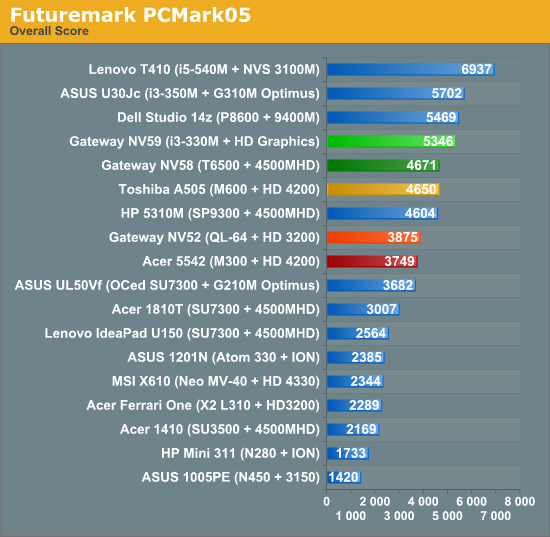
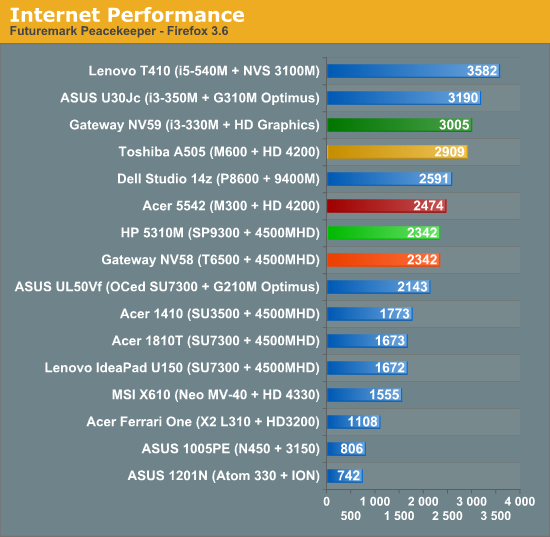
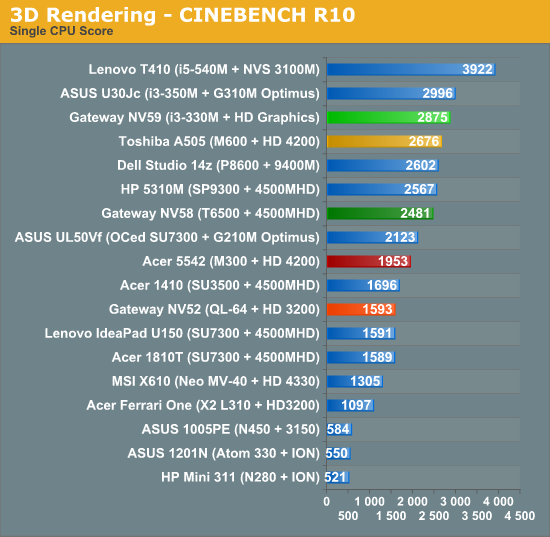
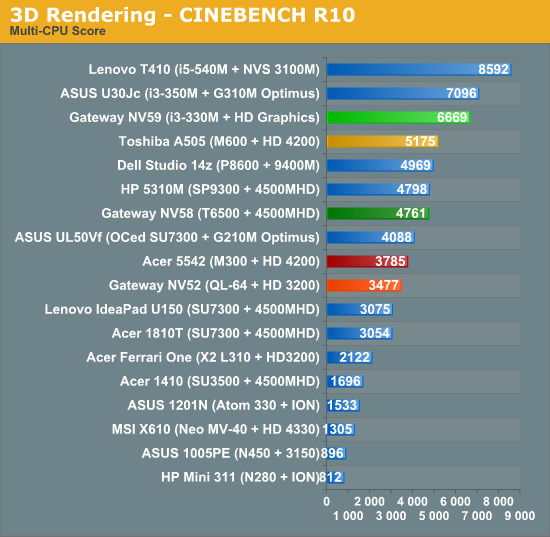
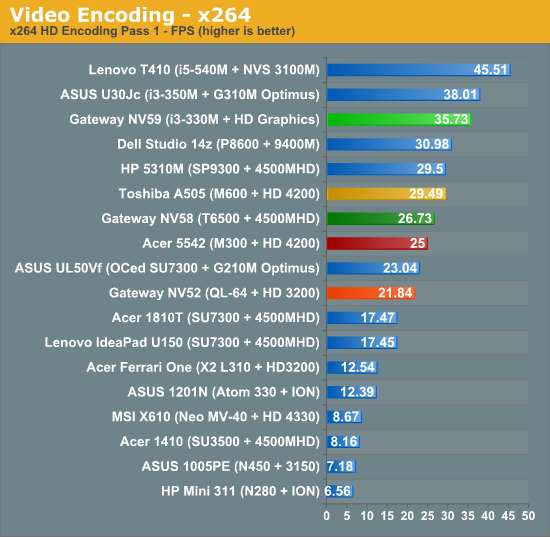

Let's start with PCMark, since it's a good representation of real world applications. PCMark puts the NV59 quite a bit ahead of the 5542, though with different hard drives there are other factors in play. The gap in Vantage is 52% while it's "only" 42% in 05, and in general use the NV59 certainly feels quite a bit faster. Results in the other application tests continue the trend of Intel leading in general performance. The closest score is in Peacekeeper, a single-threaded Internet benchmark, with the NV59 leading the 5542 by 21%. The x264 encoding advantage is 43% for pass one, and the second pass where multithreading really plays a role has the i3-330M leading by 73%. Cinebench is similar: 47% lead for i3-330M in single-threaded mode, and a 76% lead in the multi-threaded test.
It's no surprise that Intel is leading in CPU performance, as they've been ahead of AMD since Core 2 launched and Core i7/i5/i3 only increased that lead. That's not to say that the 5542 is slow, but the M300 isn't a very good competitor as far as general CPU performance is concerned. Clocked at 2.0GHz, architectural improvements make it slightly faster than the old QL-64, but chips like the M500 and M600 are much more competitive. We've included the Toshiba A5050 with a Turion II M600 for reference here, and it does much better. Of course Intel has plenty of faster CPUs as well—the i3-330M is their slowest i-Series processor. Anyway, as Atom has proven, if you're just surfing the Internet and running office applications any modern laptop is more than sufficient; these systems are substantially faster than netbooks and CULV laptops, so they're certainly in the category of "fast enough".
Also worth noting is the improvement in performance both platforms have shown relative to last year's models. We're using our Windows 7 results here, so the OS isn't a factor, and the basic entry-level AMD laptop is still 10-15% faster in many of the tests, even with a slightly lower clock speed. Clearly the change from an old K8-based architecture to the 45nm K10-based design helps, with PCMark05 being the only test where the 5542 didn't beat NV52. On the Intel side, the performance gap is much greater. The smallest gains are around 15% in single-core Cinebench and PCMark05. PCMark Vantage improves 33%, with Peacekeeper and x264 pass 1 around 30% as well. The biggest gains are in multi-threaded tests where Hyper-Threading is able to boost performance by up to 45% over the old T6500.
We also tested the latest release of Flash 10.1 with the latest drivers from both AMD and Intel. Unlike previous tests, all of our Flash video testing went off without a hitch—yes, even 1080p YouTube videos played in full screen mode without dropping frames. The NV5933u comes with a Blu-ray drive, and we also tested several Blu-ray movies, the most intensive being a 37Mbps AVC encode. There were no issues there either. But there's more to laptops than general performance, so let's look at a few other metrics.










38 Comments
View All Comments
Shadowmaster625 - Tuesday, June 22, 2010 - link
Athlon II P320 15" notebook on newegg for $400. No rebates. The deal expired quickly, but there will be more. I think it is a safe bet that AMD 25W dual core notebooks are going to be easily found all summer long for $400, and probably $300 by the time back-to-school starts. And I predict that next you will compare a P320 to a i330 that still costs twice as much.Roland00 - Tuesday, June 22, 2010 - link
While the p320 is a better battery life processor. Newegg also has the lenovo g555 (same laptop as the fry's ad) for $379.99 with free shipping (and no tax in most states).Only 3gb of memory and 160gb harddrive, but still $379.99
JarredWalton - Tuesday, June 22, 2010 - link
Next up is a Toshiba with Phenom II P920 quad-core (25W) with switchable HD 5650 graphics. I'm not sure it's the best option out there for AMD, but it's what AMD is sending me. It will at least be interesting to see how performance compares against i5-430M with the same GPU, and I'm told that the HD 4200 mode with the P920 will actually deliver better battery life than the M600/M300 stuff. We shall see.Personally, I would *love* to get one of the $400 P320 laptops for testing, but that's not happening yet unless I go and buy one. And we might just do that....
Shadowmaster625 - Thursday, June 24, 2010 - link
Wow a 1.6GHz quad core with 512k cache? I can already see that thing getting walloped by a SU7300 in everything except video encoding. (And who would do that on a notebook?)Has it occured to you that Intel makes backroom deals with companies to get them to send reviewers only these oddball AMD notebook configurations specifically to make AMD look bad? Despite losing a billion dollars by engaging in these tactics, I am sure that Intel regards it as merely a cost of doing business. No doubt they've made $10 billion through these shady tactics.
Roland00 - Thursday, June 24, 2010 - link
512k cache per core. 2mb total cache. AMD processors have each individual core possessing their own l2 cache. The new Core I series is the same way from intel. The old Intel Core2Duos and Core2Quads shared their l2 cache between 2 of the cores.Regardless 25w for 4 cores is extremely good energy wise per core. That is 6.5w per a 1.6 ghz single core or pretty much atom territory. Sadly the p520 (2.3 ghz dual core, 1 mb l2 cache per core, 2 mb l2 cache total) is going to be faster in most things, for not enough things are coded for quad cores yet.
JarredWalton - Thursday, June 24, 2010 - link
Actually, AMD sent this laptop after buying it from the manufacturer, so unless Toshiba somehow convinced AMD to send the A665, I doubt Intel had anything to do with the choice. It's doing okay on battery life (226 minutes idle with a 48Wh battery). Unfortunately, the notebook just died this morning (after less than 24 hours) while I was trying to watch the World Cup online (Flash video).I don't know if the laptop was just banged around in shipping, or if the GPU had a glitch, or what, but I do know that it is dead. It locked, I force restarted, and now the fans turn on and nothing ever shows up on the LCD. Weird. But a replacement is on the way, so the review should still come in the next 10 days or so.
Hrel - Thursday, June 24, 2010 - link
If someone could do a review on the laptop that I currently suspect is the best "bang for your buck" out there. It's made by compal, and available on Cyberpower.com who's machines you've reviewed before. If you'd like it configured like I did, which I think is the best bang for buck, do this: Go to the website. mouse over 15.6" Laptops and click on the $999 Xplorer X6-8500. It has a 1080p screen. (I'm not sure why the people who run this site do this, but even though the other configurations use the same chassis when personalized they come out to cost more than this one; annoying since it makes me configure all 3 or 4 machines built on the same base chassis to figure out which one is cheapest/best for me.) Then I configured it with the Core i7-620M CPU. (to get it over 1K so I can take advantage of the 5% off.) 4GB 0DDR3-1333, hopefully 7-7-7-21, probably not, but hopefully. ATI MR HD5650 1GB GDDR3 320GB 7200rpm HDD (I did this cause I'm gonna take that HDD out and use the Seagate Momentus XT 500GB, thanks for that review!!) Everything else on that page I left untouched. The only thing I did on page 2 was switch to Intel wifi with bluetooth; Though I'm curious if the MSI option is equal/better; 17 bucks isn't nothing. It has HDMI out and a fingerprint reader. This page says 3 USB ports, the specs sheet says 4USB ports; not sure which is true. (I do wish they were USB 3.0 ports, but I was hoping you guys would test some stuff and tell me if that even matters for use with an external hard drive, mechanical disk 7200rpm. Transferring large files like movies and games mostly.) On page 3 I select "none, format only" for the OS. And select "LCD perfect assurance" cause even 1 dead pixel is unacceptable to me. This brings the total to $1008.90 after 5% off, or $992.75 if you get the MSI network card. So yeah, I really hope you guys can get a hold of one of these for review; as a loner or given as a review unit or maybe someone will just buy one and review it cause it's really tempting me right now... like a lot! If you're review is good I'm gonna start saving up and hopefully be able to buy it around Christmas. Thanks guys! A loyal reader. - Brianshady28 - Sunday, June 27, 2010 - link
I went looking for a p920 review (quad core Phenom II for laptops) and all I'm seeing is a comparison of Intel's latest i3/i5 vs 2 year old Turion Ultra CPUs. I have a laptop I bought almost 2 years ago that is a Turion Ultra / 2.2Ghz with ATI 3200 video that is just as good as the AMD system in this comparison.
These quad core Phenoms are showing up for $700 at Wal-Mart with ATI 4250 GPUs. Wouldn't that be a more interesting comparison???